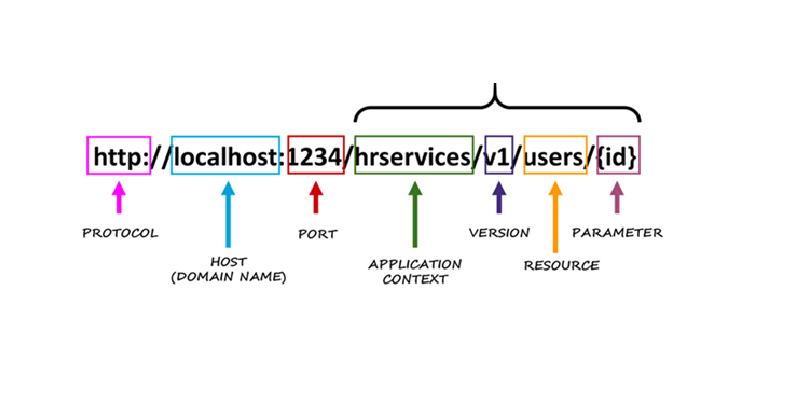
When doing business online, having a website with a good URL structure can significantly help your search engine results. The SEO-friendly URL layout must be clear, short, and easy for people and search engines to understand.
Instead of using long URLs that are hard to understand, develop a short URL slug with relevant keywords and product names. People can easily use your website and search engines to crawl and scan your pages.
So here in this blog from Creatix9, the best digital agency in UAE, we will go through the techniques to create SEO-friendly URL structures for ecommerce websites. Let’s begin with what URL anatomy actually is.
What is URL-Anatomy?
For an eCommerce website, the protocol, domain, subdomain, subfolder, top-level domain (TLD), and, most importantly, the slug are all compatible parts of the URL design.
- Protocol: The protocol determines whether the website uses SSL encryption or not. It is usually either http:// or https://.
- Domain: The domain is the website’s primary address, such as “example.com.” It represents the overall identity of the website.
- Subdomain: The subdomain is an optional part that precedes the domain and is used to organize different sections or functionalities of the website. For example, “blog.example.com” could be a subdomain for the website’s blog.
- Subfolder: A subfolder is a directory within the website’s structure that follows the domain. It helps organize content within the domain. For example, “example.com/shop” could be a subfolder for the website’s online store.
- Top-level domain (TLD): The TLD is the last part of a domain, such as .com, .net, .org, etc. It indicates the general category or purpose of the website.
- Slug: A URL part after the domain or subfolder. It usually represents a specific page or post on the website. For example, the URL “example.com/blog/how-to-create-url-slug,” “how-to-create-url-slug” is the slug.
An optimized, search engine-friendly URL is crucial for eCommerce sites. It should include relevant keywords and be concise, clear, and user-friendly. It boosts search rankings, drives organic traffic, and enhances the user experience.
At Creatix9 UAE, the top digital firm, we know how to make websites that search engines like. By optimizing URL layout and slugs, we can make a big difference in how many people visit your website and how visible it is online in general.
Techniques to Use for Crafting Search Engine-Friendly URLs for Your eCommerce Websites?
Search engine-friendly URLs improve the user experience overall for visitors to learn what the pages they’ve arrived on are about and what they contain.
Ultimately, better conversion rates come from people staying on a site longer and leaving it less often.
Start With The Title Of The Page
Whether you put the title of a page at the top or the bottom, the success of your eCommerce business depends on how interesting and appealing the title is. Catchy page titles can improve user experience and SEO. It tells your readers more about the topic you’re writing about and makes them want to read your post.
Choose a keyword you want to highlight in the title, look for long-tail versions of that phrase, and make a unique title tag.
Keep The Number Of Special Characters Low
Remove special characters from the tags to make search engine-friendly URLs for an eCommerce site.
Avoid using symbols like %, #, @, and *, as they confuse search engines and challenge people to find you on SERPs. People might need help reading and remembering these figures, which would be bad for the user experience. By leaving these characters out of URL tags, a business can make URLs easier for search engines to crawl and scan.
Eliminate Numbers
A URL with no extra numbers or factors for users to see the content.
Users often need help remembering URLs because they have numbers in them, which makes them longer, more complicated, and harder to remember.
Taking the numbers out of URLs can help improve the user’s experience by making them easier to share and understand.
Compare how hard it is to use www.example.com/products/12345 to how easy it is to use www.example.com/products/red-shoes. Also, taking the numbers out of URLs can make them look better, increasing user interaction and how people think of a brand.
Using descriptive URLs enhances the accuracy of search engines.
Exclude Extra Information In The URL
When search engines scan a website, they look at the URL to understand what the page is about and whether it matches the user’s search. Hence, it’s crucial to keep URLs brief and pertinent to the content on the page.
Putting extra words or keywords in the URL may challenge search engines to determine how relevant the content is, making the page rank lower in search results.
Shorter, more specific URLs are more accessible for users to remember and share. Because of this, it’s best to choose URLs that are clear, simple, and relevant to the website’s content without any unnecessary information.
Use Keyword Modifiers
Putting phrase modifiers in the URL can significantly affect how well your eCommerce site ranks in search engines. Keyword modifiers are words added to the main keywords to make the search question more specific. URL words clarify content and relevance to the search.
It makes the site more visible in search engine results pages (SERPs) and brings more natural traffic. Also, keyword modifiers can improve the user experience by clarifying what the page is for, making viewers more likely to stay on the page.
Put URLs That Are Easy To Read
Traditionally, URLs include a combination of numbers, letters, and symbols that provide little information about the page’s content. For example, a URL like “https://www.example.com/product?id=12345” is not user-friendly because it contains a random ID number instead of descriptive information.
You make URLs more readable and meaningful using words instead of arbitrary identifiers whenever possible. This practice is often called “slug” or “friendly URL” creation. Before clicking on a link, users can know what to expect on the page by including relevant words in the URL.
For example, instead of the previous URL, a more user-friendly version could be “https://www.example.com/product/awesome-t-shirt.” In this case, the URL includes the actual product name, “awesome t-shirt,” making it clear to users what the page is about.
Use Lowercases
Using lowercase letters for URLs is a standard convention and best practice for eCommerce web creation.
Typing URLs in lowercase makes them appear the same on all devices and browsers and allows for similar viewing.
Compared to URLs that use capital and small letters, they look cleaner and more pleasing to the eye.
Lowercase URLs make it easier for search engines to figure out how your website is ready and what it’s about, which is good for SEO. Because search engines often look at URLs with capital letters and those with lowercase letters in different ways, your SEO results may suffer.
Are you looking for the best digital agency in the UAE? Need a professional logo design company in Dubai or a top-notch web design company? Look no further! Create a connection with us now and elevate your online presence!
Make Use of HTTPS
It is essential to check if a website uses HTTPS instead of HTTP. HTTPS encrypts the data exchanged between the web server and browser, making it difficult for unauthorized parties to intercept and access the information. This provides an added layer of security compared to using HTTP.
Use Subdomains When Necessary
Subdomains are additional sections added to the front of a domain name. They allow website owners to create separate web addresses using the same primary domain for specific purposes. For example, in the URL “https://blog.example.com,” the “blog” part is a subdomain, while the main domain is “example.com.” Subdomains help organize different sections or services of a website.
Leave Out Unnecessary Parameters
Parameters are information in a URL that you can use to send data to a web application. When searching for something on a website, the search query is often included as a parameter in the URL.
However, it’s generally better to eliminate unnecessary parameters to improve the website’s performance, security, and search engine optimization (SEO). Removing unnecessary parameters simplifies the URL for users and search engines to understand and navigate.
Conclusion
A search engine-friendly web must have a URL structure that is clear and uniform. A well-structured URL makes finding their way around a website more accessible and tells search engines important information about the page’s content.
The experts at the top web design company known as Creatix9, know how important it is to organize URLs logically and consistently and use keywords in URL slugs. As the best digital agency in UAE and logo design company in Dubai, we help our customers improve their search engine rankings and get more website traffic by providing complete SEO services.

